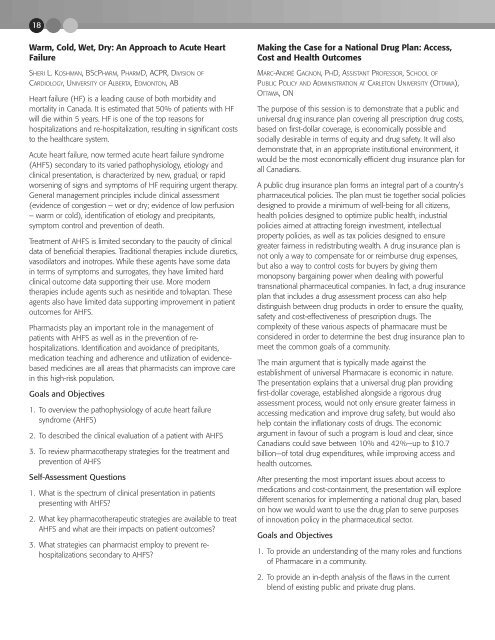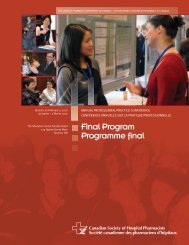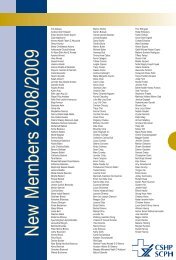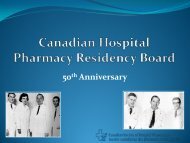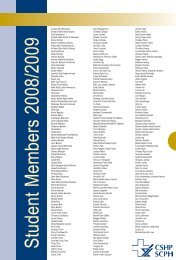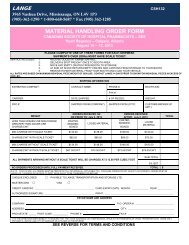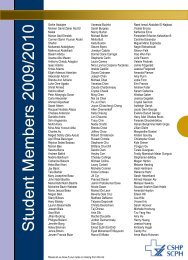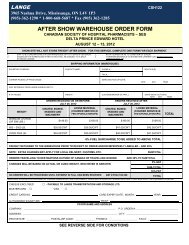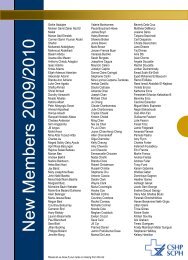Final Program - Canadian Society of Hospital Pharmacists
Final Program - Canadian Society of Hospital Pharmacists
Final Program - Canadian Society of Hospital Pharmacists
You also want an ePaper? Increase the reach of your titles
YUMPU automatically turns print PDFs into web optimized ePapers that Google loves.
18<br />
Warm, Cold, Wet, Dry: An Approach to Acute Heart<br />
Failure<br />
SHERI L. KOSHMAN, BSCPHARM, PHARMD, ACPR, DIVISION OF<br />
CARDIOLOGY, UNIVERSITY OF ALBERTA, EDMONTON, AB<br />
Heart failure (HF) is a leading cause <strong>of</strong> both morbidity and<br />
mortality in Canada. It is estimated that 50% <strong>of</strong> patients with HF<br />
will die within 5 years. HF is one <strong>of</strong> the top reasons for<br />
hospitalizations and re-hospitalization, resulting in significant costs<br />
to the healthcare system.<br />
Acute heart failure, now termed acute heart failure syndrome<br />
(AHFS) secondary to its varied pathophysiology, etiology and<br />
clinical presentation, is characterized by new, gradual, or rapid<br />
worsening <strong>of</strong> signs and symptoms <strong>of</strong> HF requiring urgent therapy.<br />
General management principles include clinical assessment<br />
(evidence <strong>of</strong> congestion – wet or dry; evidence <strong>of</strong> low perfusion<br />
– warm or cold), identification <strong>of</strong> etiology and precipitants,<br />
symptom control and prevention <strong>of</strong> death.<br />
Treatment <strong>of</strong> AHFS is limited secondary to the paucity <strong>of</strong> clinical<br />
data <strong>of</strong> beneficial therapies. Traditional therapies include diuretics,<br />
vasodilators and inotropes. While these agents have some data<br />
in terms <strong>of</strong> symptoms and surrogates, they have limited hard<br />
clinical outcome data supporting their use. More modern<br />
therapies include agents such as nesiritide and tolvaptan. These<br />
agents also have limited data supporting improvement in patient<br />
outcomes for AHFS.<br />
<strong>Pharmacists</strong> play an important role in the management <strong>of</strong><br />
patients with AHFS as well as in the prevention <strong>of</strong> rehospitalizations.<br />
Identification and avoidance <strong>of</strong> precipitants,<br />
medication teaching and adherence and utilization <strong>of</strong> evidencebased<br />
medicines are all areas that pharmacists can improve care<br />
in this high-risk population.<br />
Goals and Objectives<br />
1. To overview the pathophysiology <strong>of</strong> acute heart failure<br />
syndrome (AHFS)<br />
2. To described the clinical evaluation <strong>of</strong> a patient with AHFS<br />
3. To review pharmacotherapy strategies for the treatment and<br />
prevention <strong>of</strong> AHFS<br />
Self-Assessment Questions<br />
1. What is the spectrum <strong>of</strong> clinical presentation in patients<br />
presenting with AHFS?<br />
2. What key pharmacotherapeutic strategies are available to treat<br />
AHFS and what are their impacts on patient outcomes?<br />
3. What strategies can pharmacist employ to prevent rehospitalizations<br />
secondary to AHFS?<br />
Making the Case for a National Drug Plan: Access,<br />
Cost and Health Outcomes<br />
MARC-ANDRÉ GAGNON, PHD, ASSISTANT PROFESSOR, SCHOOL OF<br />
PUBLIC POLICY AND ADMINISTRATION AT CARLETON UNIVERSITY (OTTAWA),<br />
OTTAWA, ON<br />
The purpose <strong>of</strong> this session is to demonstrate that a public and<br />
universal drug insurance plan covering all prescription drug costs,<br />
based on first-dollar coverage, is economically possible and<br />
socially desirable in terms <strong>of</strong> equity and drug safety. It will also<br />
demonstrate that, in an appropriate institutional environment, it<br />
would be the most economically efficient drug insurance plan for<br />
all <strong>Canadian</strong>s.<br />
A public drug insurance plan forms an integral part <strong>of</strong> a country’s<br />
pharmaceutical policies. The plan must tie together social policies<br />
designed to provide a minimum <strong>of</strong> well-being for all citizens,<br />
health policies designed to optimize public health, industrial<br />
policies aimed at attracting foreign investment, intellectual<br />
property policies, as well as tax policies designed to ensure<br />
greater fairness in redistributing wealth. A drug insurance plan is<br />
not only a way to compensate for or reimburse drug expenses,<br />
but also a way to control costs for buyers by giving them<br />
monopsony bargaining power when dealing with powerful<br />
transnational pharmaceutical companies. In fact, a drug insurance<br />
plan that includes a drug assessment process can also help<br />
distinguish between drug products in order to ensure the quality,<br />
safety and cost-effectiveness <strong>of</strong> prescription drugs. The<br />
complexity <strong>of</strong> these various aspects <strong>of</strong> pharmacare must be<br />
considered in order to determine the best drug insurance plan to<br />
meet the common goals <strong>of</strong> a community.<br />
The main argument that is typically made against the<br />
establishment <strong>of</strong> universal Pharmacare is economic in nature.<br />
The presentation explains that a universal drug plan providing<br />
first-dollar coverage, established alongside a rigorous drug<br />
assessment process, would not only ensure greater fairness in<br />
accessing medication and improve drug safety, but would also<br />
help contain the inflationary costs <strong>of</strong> drugs. The economic<br />
argument in favour <strong>of</strong> such a program is loud and clear, since<br />
<strong>Canadian</strong>s could save between 10% and 42%—up to $10.7<br />
billion—<strong>of</strong> total drug expenditures, while improving access and<br />
health outcomes.<br />
After presenting the most important issues about access to<br />
medications and cost-containment, the presentation will explore<br />
different scenarios for implementing a national drug plan, based<br />
on how we would want to use the drug plan to serve purposes<br />
<strong>of</strong> innovation policy in the pharmaceutical sector.<br />
Goals and Objectives<br />
1. To provide an understanding <strong>of</strong> the many roles and functions<br />
<strong>of</strong> Pharmacare in a community.<br />
2. To provide an in-depth analysis <strong>of</strong> the flaws in the current<br />
blend <strong>of</strong> existing public and private drug plans.


